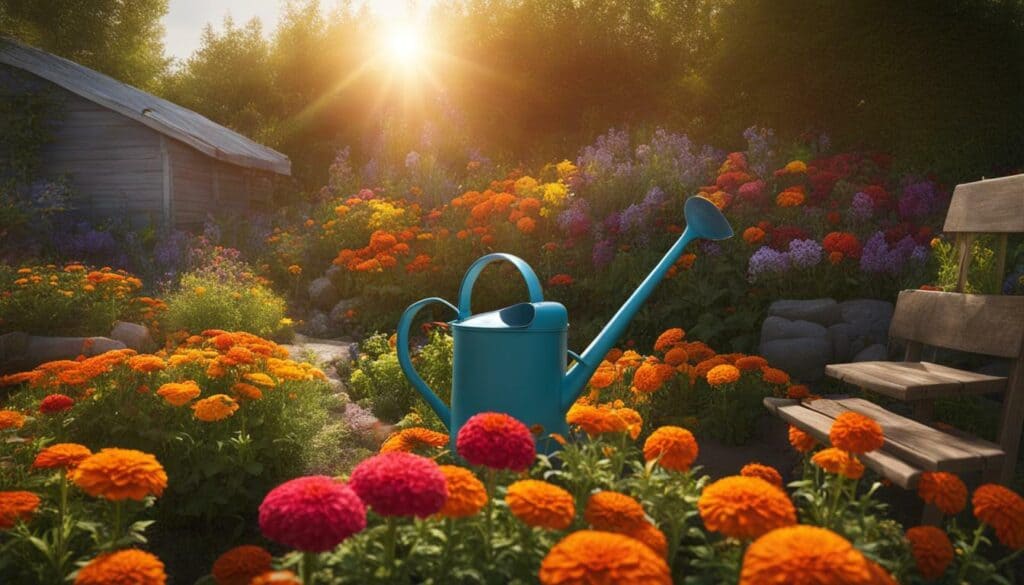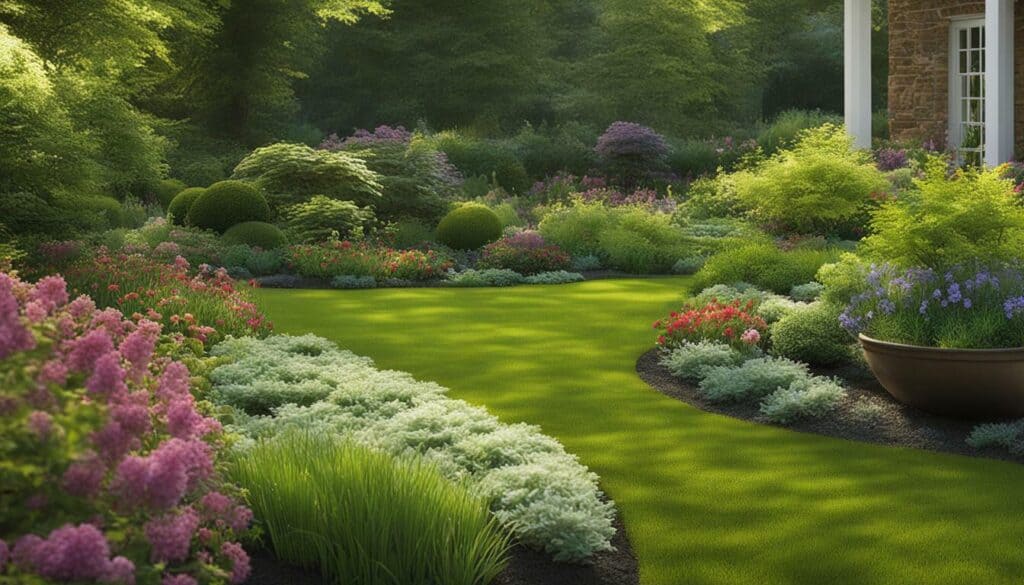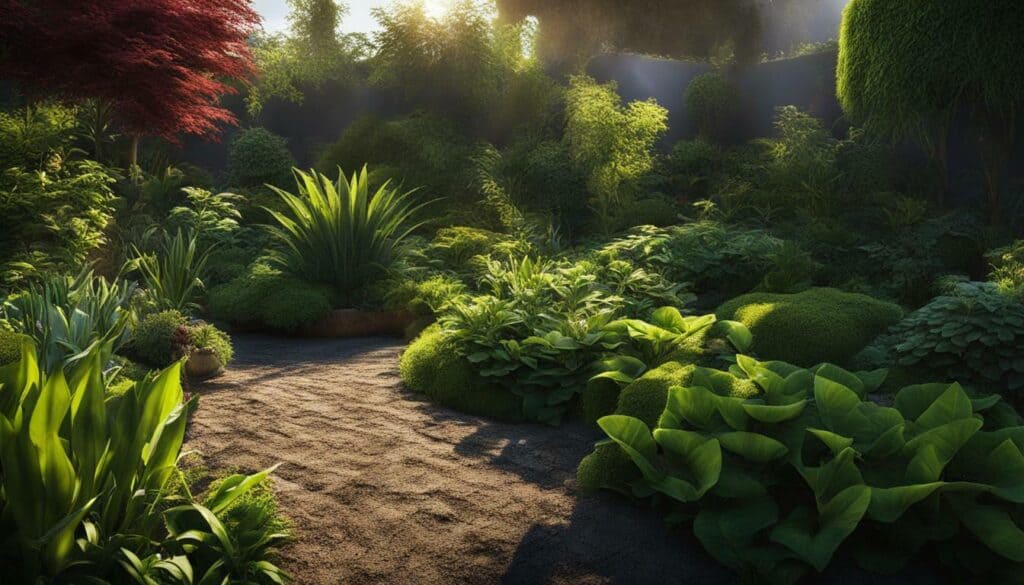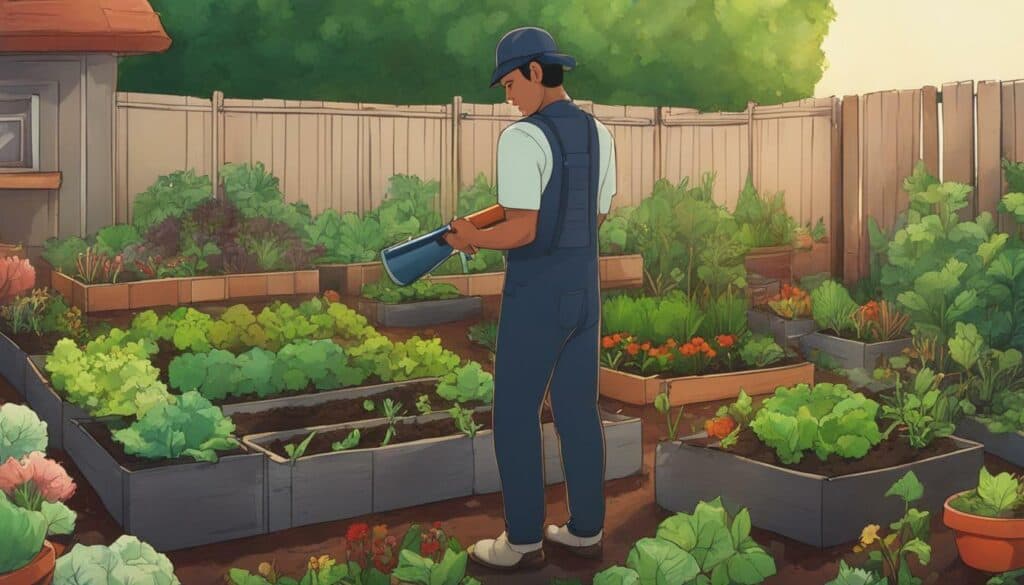Are you looking for ways to ask for help in your garden? Whether you need gardening assistance or seeking advice, these top tips will help you navigate the process smoothly.
Asking for help in your garden is a valuable practice, especially for beginners. It’s essential to know your USDA Hardiness Zone, as this will help you avoid planting trees and shrubs that won’t survive in your area. By understanding your zone, you can seek appropriate gardening assistance and support.
Pruning spring-flowering shrubs is an important task, and it should be done immediately after the blooms fade. This ensures the health and appearance of your shrubs. Additionally, applying composted, rotted manure that has cured for at least six months is highly recommended. It enhances soil fertility and provides essential nutrients to your plants, resulting in a flourishing garden.
When it comes to perennials, patience is key. These plants generally need three years to achieve their mature size. Deadheading, the practice of removing faded flowers, is also important for perennials and annuals. It encourages more flowers and redirects energy for stronger growth.
Understanding the sunlight needs of different plants is crucial for their success. Some may require full sun, while others thrive in shady areas. Controlling weeds is another essential aspect of garden care, and hand-weeding and hoeing are effective techniques for weed control.
Hostas and panicle hydrangeas are popular garden plants that require specific care. Dividing and caring for these plants should be done at the right time for the best results. Additionally, leaving some plants in the garden during fall not only benefits birds but also increases the chances of survival for perennials.
Knowing the optimal temperature for ripening tomatoes and proper care for spring-blooming bulbs are vital for a successful garden. Understanding soil quality is equally important. Healthy soil is the foundation for healthy plants. Focus on improving soil quality rather than relying solely on fertilizers.
Key Takeaways:
- Know your USDA Hardiness Zone to seek appropriate gardening assistance.
- Prune spring-flowering shrubs after blooms fade for optimal health and appearance.
- Apply composted, rotted manure for enhanced soil fertility and plant nutrition.
- Be patient with perennials, and deadhead to encourage more flowers and stronger growth.
- Understand the sunlight needs of different plants and control weeds effectively.
Remember, asking for help in your garden is not a sign of weakness but a way to ensure success. With these top tips and the right gardening assistance, you can create a beautiful and thriving garden.
One of the first steps to seeking garden help and support is understanding your USDA Hardiness Zone and how it affects the plants you can grow successfully. The USDA Hardiness Zone map divides North America into 13 different zones based on the average minimum winter temperature in each region. By knowing your zone, you can choose plants that are more likely to thrive in your specific climate.

To determine your zone, visit the USDA website or consult a local gardening expert. Once you know your zone, you can seek appropriate gardening assistance and support, including advice on what plants are best suited for your area and how to care for them.
Importance of Understanding Your Zone
Understanding your USDA Hardiness Zone is crucial for several reasons. Firstly, it allows you to select plants that are adapted to your climate, increasing their chances of survival and success. Planting species that are not suited to your zone can result in poor growth, disease susceptibility, or even the death of the plants.
Additionally, knowing your zone helps you plan your garden more effectively. By choosing plants that are well-suited to your climate, you can create a harmonious and thriving garden that requires less effort and maintenance. This not only saves you time and energy but also reduces the need for excessive garden care assistance or seeking gardening expertise.
| Zone | Temperature Range (°F) |
|---|---|
| Zone 1 | -60 to -50 |
| Zone 2 | -50 to -40 |
| Zone 3 | -40 to -30 |
| Zone 4 | -30 to -20 |
| Zone 5 | -20 to -10 |
| Zone 6 | -10 to 0 |
| Zone 7 | 0 to 10 |
| Zone 8 | 10 to 20 |
| Zone 9 | 20 to 30 |
| Zone 10 | 30 to 40 |
| Zone 11 | 40 to 50 |
| Zone 12 | 50 to 60 |
| Zone 13 | 60 to 70 |
Remember, gardening is a rewarding and enjoyable hobby, but it can be challenging without the right knowledge and support. Understanding your USDA Hardiness Zone is just one step towards seeking the garden help, garden support, and garden care assistance you need to create a flourishing and beautiful outdoor space.
Pruning Techniques for Spring-Flowering Shrubs
When it comes to spring-flowering shrubs, knowing how and when to prune can make a significant difference in their overall health and blooming potential. Proper pruning helps maintain the shape of the shrubs, encourages new growth, and ensures abundant blooms year after year.
Here are some essential tips for pruning spring-flowering shrubs:
- Timing is crucial: Pruning should be done immediately after the blooms fade. This allows the shrub to focus its energy on growing new branches and setting buds for the following year’s flowers.
- Remove dead and diseased wood: Start by cutting out any dead or diseased branches. This helps prevent the spread of disease and promotes better overall plant health.
- Thin out overgrown areas: If your shrub has become thick and dense, selectively remove some of the older branches from the center to improve airflow and light penetration.
- Shape the shrub: Prune to maintain the desired shape of your shrub. Remove any crossing branches or those that grow inward, as they can rub against each other and cause damage.
Remember to always use sharp and clean pruning tools to make clean cuts and minimize the risk of disease transmission. If you’re unsure about the proper pruning techniques for a specific shrub, consult with a local gardening expert or horticulturist for guidance.

Pruning spring-flowering shrubs is an essential gardening practice that promotes healthier growth and vibrant blooms. With the right knowledge and techniques, you can confidently maintain and enhance the beauty of your garden.
| Benefits of Proper Pruning | Tips for Pruning |
|---|---|
| Encourages new growth | Prune immediately after blooms fade |
| Promotes better airflow and light penetration | Remove dead and diseased wood |
| Provides shape and structure | Thin out overgrown areas |
| Prevents rubbing and damage from crossing branches | Shape the shrub |
The Benefits of Composted, Rotted Manure
If you’re looking for a natural and nutrient-rich way to improve your garden’s soil, composted, rotted manure can be a game-changer. Not only does it provide essential nutrients for your plants, but it also enhances soil fertility and promotes healthy root development. This organic matter is a valuable addition to any garden, whether you have a small plot or a large-scale landscape.
Composting manure is a process that involves allowing animal waste to decompose over time. Through this process, harmful bacteria and pathogens are reduced, making the manure safe to use in your garden. Composted manure is rich in organic matter, which improves soil structure, increases moisture retention, and encourages beneficial microorganisms to thrive.
When applying composted, rotted manure, it’s important to choose well-cured manure that has been composted for at least six months. This ensures that any potential weed seeds or harmful bacteria have been broken down. Spread a layer of composted manure over your garden beds, mixing it into the top few inches of soil. You can also use it as a mulch around existing plants to provide a slow-release source of nutrients.
| Benefits of Composted, Rotted Manure |
|---|
| Improves soil fertility |
| Enhances soil structure |
| Increases moisture retention |
| Provides essential nutrients |
| Encourages beneficial microorganisms |
When using composted manure, it’s important to remember that it should be used in moderation. Excessive application can lead to nutrient imbalances or nutrient runoff, so follow recommended guidelines for your specific plants and soil conditions. Additionally, be cautious when using manure from animals that have been fed with herbicide-treated hay or grain, as these chemicals can persist in the manure and potentially harm your garden.
By incorporating composted, rotted manure into your garden, you can create a nutrient-rich environment that promotes healthy plant growth and maximizes your garden’s potential. So, next time you’re looking for garden support or advice for garden problems, consider the benefits of composted manure as a natural and sustainable solution.

When it comes to perennials, patience is key. Understanding their growth process will help you nurture them to their full potential. Perennials are plants that live for more than two years, often flowering in spring or summer and going dormant in winter. Unlike annuals, which complete their life cycle in one season, perennials take time to establish their root systems and reach their mature size. While it may be tempting to expect immediate results, it’s important to remember that the rewards of a well-established perennial garden are worth the wait.
To help you navigate the growth process of perennials, here are some key factors to consider:
- Timeline: Perennials generally need three years to achieve their mature size. During this time, they will gradually increase in size and produce more blooms each year. Understanding the timeline allows you to have realistic expectations and avoid unnecessary frustration.
- Deadheading: Deadheading, the removal of spent flowers, is a good practice for both perennials and annuals. This not only improves the visual appearance of the plants but also encourages more flowers and redirects energy for stronger growth. Regular deadheading can prolong the blooming period and keep your garden looking fresh and vibrant.
- Common Issues: While perennials are generally low-maintenance, they can face common issues like pests, diseases, and nutrient deficiencies. Being attentive to signs of trouble and taking appropriate action will help you address these issues promptly and ensure the health of your plants.
By understanding the growth process of perennials and implementing the necessary care and maintenance, you can create a beautiful and flourishing garden that will reward you with year after year of vibrant blooms.

| Key Factors | Benefits |
|---|---|
| Patience | Allows perennials to establish their root systems and reach their full potential. |
| Deadheading | Encourages more flowers and redirects energy for stronger growth. |
| Common Issues | Promptly address pests, diseases, and nutrient deficiencies for healthier plants. |
Sunlight Needs and Weeding Techniques
Providing the right amount of sunlight to your plants and keeping weeds at bay are crucial aspects of garden care that often require expert advice. Understanding the specific sunlight requirements of different plants is essential for their optimal growth and development. Some plants thrive in full sun, while others prefer partial shade or full shade. Consulting with a gardening expert can help you determine the best placement for your plants and ensure they receive the appropriate amount of sunlight.
In addition to sunlight, another important factor in maintaining a healthy garden is weed control. Weeds compete with your plants for nutrients, water, and sunlight, hindering their growth and reducing their overall health. Proper weed management techniques will help you keep your garden weed-free and maintain a tidy and well-maintained appearance. Hand-weeding and hoeing are effective methods to remove weeds manually, especially in smaller garden areas.
When it comes to larger garden spaces, mulching can be a valuable tool for weed prevention. Applying a layer of organic mulch, such as wood chips or straw, can help suppress weed growth by blocking their access to sunlight. Mulch also helps retain moisture in the soil, reducing the need for frequent watering. However, it is important to avoid piling mulch too close to the stems of your plants, as this can create a damp environment that encourages disease and pest issues.
| Top Tips for Sunlight and Weed Management |
|---|
| 1. Consult a gardening expert to determine the sunlight needs of your plants and place them accordingly. |
| 2. Hand-weed and hoe regularly to prevent weeds from overtaking your garden. |
| 3. Use mulch to suppress weed growth and retain soil moisture, but be mindful of proper application. |
| 4. Consider using organic weed control methods, such as vinegar or boiling water, for targeted weed removal. |
| 5. Stay on top of weed management throughout the growing season to prevent weed seeds from spreading and taking over your garden. |

By implementing these strategies for sunlight management and weed control, you can create an environment that promotes healthy plant growth and minimizes the competition from unwanted weeds. Don’t hesitate to seek expert advice when needed to ensure your garden thrives with the right amount of sunlight and remains free from invasive weeds.
Dividing and Caring for Hostas and Panicle Hydrangeas
If you have hostas or panicle hydrangeas in your garden, you’ll want to know the best practices for their care and understand when to seek garden support for any problems that may arise. Hostas, with their beautiful foliage, are a popular choice for shady areas, while panicle hydrangeas bring stunning flower clusters to sunny spots. Both of these plants require specific attention to ensure their health and longevity.
When it comes to dividing hostas, early spring or fall is the ideal time. Dividing them not only helps manage their size but also revitalizes the plants. Dig up the clump and separate the individual plants using a sharp spade or knife. Be sure to leave several growing points on each division, and replant them in well-prepared soil enriched with organic matter. Regular watering and mulching will aid in the establishment of the divided hostas.
Panicle hydrangeas, on the other hand, thrive in sunny locations and require minimal care. These hardy shrubs are known for their cone-shaped flower clusters that bloom from summer to fall. To encourage abundant flowering, prune the shrub in late winter or early spring, before new growth emerges. Remove any dead or damaged branches, and trim back the stems to maintain a desired shape. If you encounter any issues with your panicle hydrangeas, such as leaf discoloration or poor flowering, it is advisable to seek garden support for expert advice tailored to your specific situation.
| Hostas Care Tips | Panicle Hydrangeas Care Tips |
|---|---|
| Divide hostas in early spring or fall | Prune in late winter or early spring |
| Replant divisions in well-prepared soil | Remove dead or damaged branches |
| Water regularly and mulch | Trim back stems to maintain shape |
Remember, proper care and maintenance are essential for the health and beauty of your hostas and panicle hydrangeas. By following the recommended practices and seeking garden support when needed, you can ensure these plants thrive in your garden and bring joy for years to come.

As the gardening season transitions to fall, it’s essential to adjust your approach and seek expert advice for any challenges you may encounter. Fall brings unique opportunities and challenges for gardeners, and with the right knowledge, you can ensure a successful and thriving garden. Here are some tips and considerations for fall gardening:
The Benefits of Leaving Plants for Wildlife
In addition to enjoying the visual beauty of your garden, it’s important to create a habitat that supports local wildlife. Leaving some plants in the garden during fall provides food and shelter for birds, insects, and other creatures. These plants offer natural sources of food and nectar, helping to sustain wildlife populations and promoting a healthy ecosystem. By leaving certain plants untrimmed and seedheads intact, you can contribute to the overall biodiversity of your garden.

Consider incorporating native plants into your garden, as they are often better adapted to your area and provide essential resources for local wildlife. Additionally, native plants tend to require less maintenance and are more resistant to pests and diseases. To attract birds, you can plant shrubs and trees that produce berries or have dense foliage that provides shelter. Remember to provide clean water sources, such as bird baths or small ponds, as well.
Fall Gardening Tips
As the temperatures start to drop and the days become shorter, your garden’s needs will change. Here are some fall gardening tips to help you navigate this season:
- Focus on soil quality: Late summer or early autumn is an excellent time to improve your soil. Test your soil’s pH and amend it accordingly to ensure optimal nutrient availability for your plants. Adding organic matter, such as compost or well-rotted manure, can enhance soil fertility and structure.
- Divide and transplant perennials: This is the ideal time to divide and transplant spring-blooming perennials. By dividing overcrowded plants, you can rejuvenate them and promote healthier growth. Remember to water them thoroughly after transplanting and continue to provide sufficient water until they establish themselves.
- Plan for next year: Use the fall season to plan for the upcoming year. Consider the specific planting times for different vegetables and plan your garden layout accordingly. You can use a garden planning tool to help with the layout and spacing of your crops. Take note of any issues or successes from the current season, and make adjustments accordingly.
| Tip | Key Takeaway |
|---|---|
| 1. Focus on soil quality | Improving soil fertility and structure is essential for healthy plants. |
| 2. Divide and transplant perennials | Rejuvenate overcrowded plants and promote healthier growth. |
| 3. Plan for next year | Use the fall season to plan for the upcoming gardening year. |
By following these fall gardening tips and considering the needs of your garden’s wildlife, you can ensure a vibrant and thriving outdoor space. Remember, seeking expert advice is always valuable when facing garden challenges, so don’t hesitate to consult with gardening professionals or local gardening communities for additional support.
Understanding Tomato Ripening and Spring-Blooming Bulbs
Maximizing the flavor and color of your tomatoes and ensuring beautiful blooms from your spring-blooming bulbs involves understanding their specific needs and seeking expert guidance when necessary. Let’s delve into the details so you can cultivate thriving plants and enjoy a bountiful garden.
When it comes to tomatoes, knowing the optimal temperature for ripening is crucial. The ideal range is between 68-77°F (20-25°C). Temperatures below 50°F (10°C) can hinder ripening and negatively impact fruit color. To encourage the best results, monitor the temperature and provide appropriate shelter or coverings if needed.
For spring-blooming bulbs such as tulips and daffodils, proper care and attention are essential for vibrant blooms. Plant these bulbs in the fall, ideally six to eight weeks before the ground freezes. This allows them to establish roots before winter sets in. Deadheading spent flowers helps redirect the plant’s energy into bulb growth, ensuring healthy flowers for the following spring.
| Bulb Variety | Optimal Planting Depth | Spacing |
|---|---|---|
| Tulips | 6-8 inches (15-20 cm) | 4-6 inches (10-15 cm) |
| Daffodils | 6-8 inches (15-20 cm) | 4-6 inches (10-15 cm) |
| Crocus | 3-4 inches (7.5-10 cm) | 2-3 inches (5-7.5 cm) |
To ensure the best results with tomato ripening and spring-blooming bulbs, it is beneficial to seek gardening expertise. Local garden centers, online forums, and horticultural experts can provide valuable advice tailored to your specific region and climate. By combining your knowledge with their guidance, you can create an environment that nurtures healthy plants and yields impressive results.
Soil Quality and Planning for a Successful Garden
A successful garden starts with healthy soil. Understanding soil quality and proper planning are key steps in creating a garden that thrives throughout the season. By focusing on soil health and strategically planning your garden layout, you can ensure optimal conditions for your plants to grow and flourish.
Knowing Your Soil
Before you start planting, it’s important to assess the quality of your soil. Different plants have different soil requirements, so understanding the composition of your soil will help you choose the right plants and make any necessary amendments. Conduct a soil test to determine the pH level, nutrient content, and texture of your soil. This will guide you in selecting the appropriate fertilizers and soil amendments to improve its quality.
Soil testing is a simple process that can be done with a DIY kit or by sending a sample to a local extension office. The results will provide valuable insights into your soil’s composition and help you make informed decisions about its improvement.
Amending the Soil
If your soil lacks essential nutrients or has poor drainage, you can amend it to create a healthier growing environment. Add organic matter such as compost, well-rotted manure, or peat moss to improve soil structure and fertility. These amendments will enhance water retention, promote beneficial microbial activity, and provide vital nutrients for your plants.
| Soil Amendment | Benefits |
|---|---|
| Compost | Improves soil structure and moisture retention |
| Manure | Enhances soil fertility and promotes microbial activity |
| Peat Moss | Aids in moisture retention and increases organic matter content |
Garden Planning
Once you’ve assessed and amended your soil, it’s time to plan your garden layout. Consider the specific planting times, space requirements, and companion planting options for different vegetables and flowers. Determine the appropriate location for your garden that receives adequate sunlight and has good drainage.
Creating a garden plan can help you visualize the layout and spacing of your plants. There are various online garden planning tools available that provide templates and guidance, making it easier to organize your garden and ensure optimal growth conditions for every plant.
Remember to start small and choose vegetables that your family enjoys eating. Native plant species are often better adapted to your area and require less maintenance. By selecting the right plants, improving soil quality, and planning your garden effectively, you’ll be well on your way to a successful garden.

Asking for help in your garden can make a significant difference in its overall success. By implementing these tips and seeking expert advice when necessary, you’ll be well on your way to creating a beautiful and thriving garden.
Whether you’re a beginner or an experienced gardener, reaching out for assistance and guidance is a valuable practice. Knowing your USDA Hardiness Zone is crucial to ensure that the trees and shrubs you choose can survive and thrive in your specific area.
When it comes to pruning spring-flowering shrubs, timing is key. It’s best to prune them immediately after the blooms fade to promote healthy growth and vibrant blooms for the following year.
Applying composted, rotted manure that has been properly cured for at least six months is an effective way to enhance your soil’s fertility and provide essential nutrients for your plants.
Patience is key when it comes to perennials. These plants generally need three years to achieve their mature size, and deadheading can encourage more flowers and stronger growth.
Pay close attention to the sunlight needs of different plants in your garden, and implement effective weed control techniques such as hand-weeding and hoeing.
If you have hostas or panicle hydrangeas, dividing and caring for these plants properly is essential. Seek expert advice when needed to address any issues that may arise.
During the fall, take care of your garden by following specific tips tailored to this season. Leaving some plants for wildlife can benefit birds and increase the chances of survival for your perennials.
Understanding the optimal temperature for ripening tomatoes and proper care for spring-blooming bulbs will contribute to a successful garden.
Remember that soil quality is crucial for healthy plants. Focus on improving soil drainage and consider the specific needs of different plant species.
Start small with a garden that is manageable and choose vegetables that your family enjoys eating. Select an appropriate location that receives adequate sunlight and drains well, and plan your garden based on specific planting times for different vegetables.
By utilizing a garden planning tool, you can efficiently layout and space your garden for optimal growth.
With these tips and an open willingness to seek assistance when needed, you can create a garden that is not only visually stunning but also thriving with healthy plants.
FAQ on Asking for Help in Your Garden
Q: Is it beneficial to ask for help in my garden as a beginner?
A: Absolutely! Asking for help in your garden is a valuable practice, especially for beginners. It can provide guidance, tips, and troubleshooting advice to ensure your garden thrives.
Q: Why is it important to know my USDA Hardiness Zone?
A: Knowing your USDA Hardiness Zone is crucial because it helps you choose plants that can survive in your specific area. It ensures you select the right plants for your garden, increasing your chances of success.
Q: When should I prune spring-flowering shrubs?
A: Pruning spring-flowering shrubs should be done immediately after the blooms fade. This timing allows the shrub to set buds for the following year while still enjoying the beauty of the current blooms.
Q: Is applying composted, rotted manure beneficial for my garden?
A: Yes, applying composted, rotted manure that has cured for at least six months is recommended. It enriches the soil with nutrients and improves its overall health, leading to healthier and more vibrant plants.
Q: How long does it take for perennials to reach their mature size?
A: Perennials generally need three years to achieve their mature size. It’s important to be patient and allow them time to establish and grow before expecting their full potential.
Q: Why is deadheading important for perennials and annuals?
A: Deadheading, or removing spent flowers, is a good practice for perennials and annuals. It encourages more flowers to bloom and directs the plant’s energy towards stronger growth, resulting in a more beautiful and healthy garden.
Q: How can I control weeds in my garden effectively?
A: Hand-weeding and hoeing are effective ways to control weeds in your garden. By physically removing the weeds, you can eliminate them without relying solely on chemical herbicides, creating a healthier environment for your plants.
Q: When is the best time to divide hostas?
A: Hostas can be divided in either the spring or fall. Both seasons offer ideal conditions for successful division, allowing you to expand your hosta collection or rejuvenate existing plants.
Q: Do panicle hydrangeas need sun for the best flowering?
A: Yes, panicle hydrangeas require sun for the best flowering. They thrive in full sun or part shade, so be sure to plant them in a location that receives adequate sunlight to enjoy their beautiful blooms.
Q: Should I leave some plants in my garden during fall?
A: Yes, leaving some plants in the garden during fall benefits birds and increases the chances of survival for perennials. The seedheads and foliage provide food and shelter for birds, while the presence of plants can protect perennials’ crowns from extreme cold.
Q: What is the optimal temperature for ripening tomatoes?
A: The optimal temperature for ripening tomatoes is around 70-75°F (21-24°C). This temperature range promotes the best fruit color development, ensuring your tomatoes are delicious and vibrant.
Q: When should I plant spring-blooming bulbs?
A: Spring-blooming bulbs should be planted in the fall. This timing allows the bulbs to establish roots before winter and ensures they bloom beautifully in the following spring.
Q: Is soil quality more important than fertilizer for healthy plants?
A: Yes, focusing on soil quality is crucial for healthy plants. Good soil provides the necessary nutrients and a balanced pH level, creating an environment that allows plants to thrive. While fertilizer is beneficial, it should be used in conjunction with quality soil.
Q: When is the best time to divide and transplant spring-blooming perennials?
A: Late summer or early autumn is the best time to divide and transplant spring-blooming perennials. This timing allows the plants to establish root systems before winter and ensures successful growth in the following spring.
Q: Should I remove flower stalks from rhubarb?
A: Yes, it’s advisable to remove the flower stalks from rhubarb to prioritize foliage production. By redirecting the plant’s energy towards foliage growth, you’ll enjoy larger and healthier rhubarb leaves for culinary use.
Q: How can I improve the drainage of my soil?
A: To improve the drainage of your soil, it’s important to consider its composition. Adding organic matter such as compost or well-rotted manure can help improve drainage. Additionally, avoiding overwatering and ensuring proper garden infrastructure, such as raised beds or trenches, can also assist with drainage.
Q: Do some plants flower in response to day length?
A: Yes, some plants, known as photoperiodic plants, flower in response to day length. They require specific durations of daylight or darkness to initiate the flowering process. Understanding these requirements can help you plan and care for these plants accordingly.
Q: Are native plant species better adapted to my area?
A: Yes, native plant species are often better adapted to your area’s climate, soil, and native wildlife. They can offer several benefits, including increased resilience, reduced maintenance, and enhanced support for local ecosystems.
Q: How should I start my garden if I’m a beginner?
A: It’s best to start small with a garden that is manageable for your skills and available time. Begin by choosing vegetables that your family enjoys eating, select an appropriate location that receives adequate sunlight and drains well, and plan your garden layout based on specific planting times for different vegetables. You can also use a garden planning tool to help with the layout and spacing of your garden.





Leave a Reply